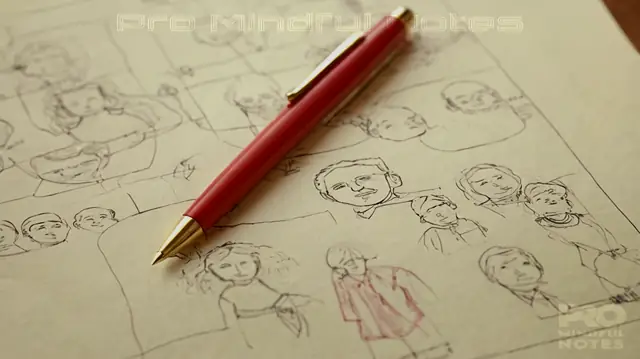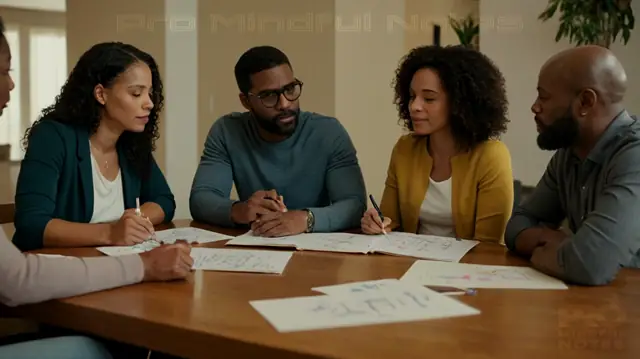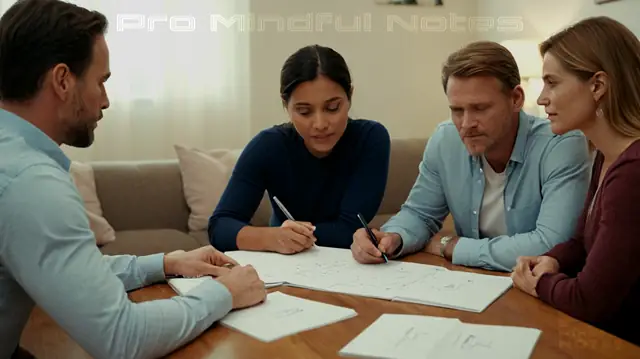Effective note-taking for family therapists: Strategies for capturing complex session dynamics

In this article, we will delve into the importance of effective note-taking for family therapists. Writing a family therapy progress note example is an essential aspect of clinical care that requires documenting interactions, reports, assessments, and observations made during family therapy sessions. Unlike individual therapy notes, family therapy notes require capturing complex dynamics and relationships between multiple people in a single session.
To create comprehensive and meaningful family therapy note example, it's crucial to consider the relational dynamics, communication patterns, and power shifts between family members. Therapists should also think about who will be billed as the identified patient and provide a concise summary of the session, including significant events, interventions, and observations. By doing so, we can create family therapy note example that effectively captures the complexities of family dynamics and facilitates informed decision-making for future sessions.
In this article, we will explore strategies for capturing complex session dynamics, such as identifying key players and observing interactions, as well as tips for writing a clear and concise note. We'll also examine the importance of considering the identified patient and how this affects the note-taking process.
- Understanding the importance of effective note-taking in family therapy
- Documenting relational dynamics and power shifts
- Strategies for capturing complex session interactions
- Using templates and frameworks to organize notes
- Focusing on key events, interventions, and observations
- Balancing accuracy with brevity
- Best practices for storing and retrieving notes
- Conclusion
- Video about Effective note-taking for family therapists: Strategies for capturing complex session dynamics
Understanding the importance of effective note-taking in family therapy

Effective note-taking is an essential aspect of family therapy, as it allows therapists to capture complex session dynamics and track family therapy progress. A well-written family therapy progress note can serve as a valuable tool for treatment planning, communication with other healthcare providers, and billing purposes. Moreover, effective note-taking enables therapists to identify patterns and trends in family interactions, which is crucial for developing targeted interventions and promoting positive outcomes.
In family therapy sessions, multiple individuals interact with each other, making it challenging to capture the complexity of relationships, emotions, and behaviors. Family therapy notes must accurately reflect these dynamics, highlighting key events, interactions, and interventions. By incorporating relevant details into the note-taking process, therapists can create a comprehensive record that informs future sessions and helps them refine their treatment strategies.
For instance, consider a family therapy session where a child expresses concerns about their parent's new romantic partner. A family therapy note example might include: "During today's session, [Child's Name] expressed anxiety about the new partner, stating 'I don't want her around.' This prompted an exploration of feelings and boundaries, leading to a discussion about healthy communication." Such notes not only document key events but also provide valuable insights for future sessions.
Documenting relational dynamics and power shifts
In family therapy, observing and objectively documenting relational dynamics is crucial for capturing the complexity of the session. As you take notes, pay attention to power shifts between family members, noting who holds influence over others, who seems most invested in the conversation, and how these dynamics impact the overall flow of the session. For instance, a family therapy note example might read: "During the discussion about the children's behavior, Mom seemed to dominate the conversation, while Dad appeared more passive, deferring to her opinions."
When documenting power shifts, be mindful of potential biases and try to remain neutral. Remember that power dynamics can change throughout the session, so continue to observe and note these changes as they occur. In a family therapy progress note example, you might write: "As the session progressed, Dad began to assert himself more, sharing his concerns about his wife's parenting style." By capturing these power shifts, you can better understand the underlying relationships and dynamics that shape the family's interactions.
When documenting relational dynamics, also pay attention to family members' communication patterns. Note how they interrupt each other, avoid certain topics, or use humor to deflect tension. A family therapy note example might read: "Siblings often talked over each other, but when Mom attempted to join the conversation, they suddenly became quieter and more attentive." By capturing these communication patterns, you can gain insight into how family members interact with each other and potentially identify areas for growth and improvement.
Strategies for capturing complex session interactions
When documenting family therapy sessions, it's essential to capture the intricate dynamics between family members. This can be achieved by paying attention to power shifts, where one family member may dominate the conversation or decision-making process. For instance, during a recent family therapy session, John (the identified patient) dominated the discussion, while his wife, Sarah, remained quiet and reserved. This observation could be documented in the family therapy note example as follows: "During the session, power shifted from [Sarah] to [John], indicating a possible imbalance in their relationship." By acknowledging these power dynamics, you can better understand the family's communication patterns and identify areas for intervention.
Another crucial aspect of capturing complex session interactions is documenting emotional tone. This involves noting the overall emotional atmosphere within the room and how it affects each family member. For example, during a family therapy session, the atmosphere became tense when discussing financial decisions. This tension could be reflected in the family therapy note example as follows: "The emotional tone shifted from calm to tense when discussing [financial decisions], highlighting the need for further exploration." By acknowledging these emotional shifts, you can gain insight into the family's coping mechanisms and identify potential areas of conflict.
In addition to power shifts and emotional tone, it's essential to capture key interactions between family members. These interactions may reveal underlying issues or themes that require attention. For instance, during a recent session, Emily (the identified patient) became visibly upset when discussing her relationship with her sister. This interaction could be documented in the family therapy note example as follows: "[Emily] became emotionally distressed when discussing [relationship], suggesting unresolved issues and potential conflict." By capturing these key interactions, you can better understand the family's dynamics and identify areas for further exploration.
By incorporating these strategies into your note-taking process, you can create comprehensive and informative family therapy progress note examples that accurately capture the complexities of family therapy sessions.
Using templates and frameworks to organize notes
Organizing your family therapy notes can be a crucial aspect of clinical care, especially when dealing with complex session dynamics. One effective way to do this is by utilizing templates and frameworks specifically designed for family therapy progress note examples. These tools provide a structure that guides you in capturing the essential information from each session. By using a standardized template, you can ensure that your notes are comprehensive, yet concise.
For instance, you could use a framework like the one used in family therapy note example: the GIRP format. This stands for Goal, Intervention, Response, and Progress/Purpose. Start by listing the family therapy progress note example's goal or main focus of the session. Then, document any relevant interventions or strategies implemented during the session. Next, describe the family members' responses to these interventions and any notable shifts in their dynamics. Finally, summarize the progress made and the purpose of the next steps.
Using templates and frameworks for organizing your notes can also help you keep track of important details and family therapy note example. This can include noting changes in family members' behaviors, coping mechanisms, or communication styles. By consistently using a template, you'll be able to quickly identify trends, patterns, and progress over time, which is essential for effective treatment planning and evaluation.
Focusing on key events, interventions, and observations
When writing a family therapy note, it's essential to concentrate on the most significant events that occurred during the session, as well as any notable interventions or observations made by the therapist. By prioritizing these details, you'll be able to effectively capture the complex dynamics of the family system in action.
For instance, when documenting a particularly intense argument between two family members, it's crucial to describe the specific words and actions that led to the escalation, as well as any subsequent attempts at reconciliation. In family therapy note example format, this might look like: "During the session, John and Sarah's disagreement over household chores escalated into a heated debate. I intervened by asking them to identify the underlying emotions driving their frustration, which helped them to diffuse the tension and reframe their conversation in a more constructive light."
When summarizing key events, it's also important to consider the therapist's role in facilitating or influencing these events. For example, did you intervene with a specific technique or question that helped shift the family's dynamics? This level of detail is critical for providing family therapy progress note example that accurately reflects the family's journey and any progress made during the session.
By focusing on key events, interventions, and observations, you'll be able to create a comprehensive and accurate family therapy note that effectively captures the complex interactions and relationships within the family system. This will enable you to provide high-quality care and track meaningful changes over time.
Balancing accuracy with brevity

In writing effective family therapy notes, family therapists must navigate a delicate balance between accuracy and brevity. It's essential to provide a thorough account of the session dynamics, interactions, and progress made during the meeting while also keeping the note concise and focused. The goal is to provide a comprehensive summary that effectively captures the essence of the session without overwhelming the reader with too much detail.
To achieve this balance, family therapists can use specific formats or templates for their family therapy progress note example. For instance, they might organize their notes around specific themes, such as relationship dynamics, communication patterns, or goals achieved during the session. By structuring their notes in a logical and coherent manner, family therapists can ensure that their observations are accurate and easy to follow. A well-structured note not only facilitates billing and reimbursement but also serves as a valuable reference for future sessions.
In practice, balancing accuracy with brevity might look like this: Imagine writing a family therapy note example that begins by summarizing the session's main events and interventions. This could be followed by a concise description of the family members' interactions, highlighting patterns or shifts in their communication styles. Finally, the note might conclude with a brief summary of progress made and goals for future sessions. By striking this balance between detail and concision, family therapists can create notes that are both informative and efficient to read.
Best practices for storing and retrieving notes

To ensure seamless access to family therapy notes, it's essential to establish a comprehensive storage and retrieval system. This can be achieved by using a combination of physical and digital methods. For instance, therapists can store family therapy progress note examples in a designated filing cabinet or binder, while also keeping a digital copy on their computer or cloud-based storage platform.
When retrieving notes, it's crucial to use an organized system that allows for quick location and review of specific sessions. This can be accomplished by categorizing notes by patient name, date of session, or family member, and labeling them accordingly. Additionally, therapists should consider creating a family therapy note example template to ensure consistency in documentation across all sessions.
Another essential aspect of note storage is maintaining confidentiality and adhering to HIPAA regulations. This can be achieved by encrypting digital files and storing physical copies in a secure location accessible only to authorized personnel. Furthermore, therapists should regularly back up their digital notes to prevent data loss due to hardware failure or cyber attacks.
Conclusion

Effective note-taking is essential for family therapists, as it allows them to track progress, identify patterns, and make informed decisions about treatment planning. By incorporating the strategies outlined in this article into their practice, family therapists can develop a comprehensive and effective way of capturing complex session dynamics.
To illustrate the importance of accurate note-taking, let's consider a family therapy progress note example: John, a 35-year-old father, has been struggling with anger issues that have affected his relationships with his wife and children. After several sessions, he begins to open up about the root causes of his frustration – feeling overwhelmed by work and family responsibilities. A thorough family therapy note example would capture this breakthrough moment, including the specific interventions used (e.g., "I acknowledged John's emotional expression" or "I normalized his feelings"). This allows for a detailed understanding of the progress made in each session and enables informed decision-making about future sessions.
By incorporating these strategies into their note-taking practice, family therapists can ensure that their notes are comprehensive, accurate, and useful for treatment planning and communication with clients.
Video about Effective note-taking for family therapists: Strategies for capturing complex session dynamics
Leave a Reply


Related Posts